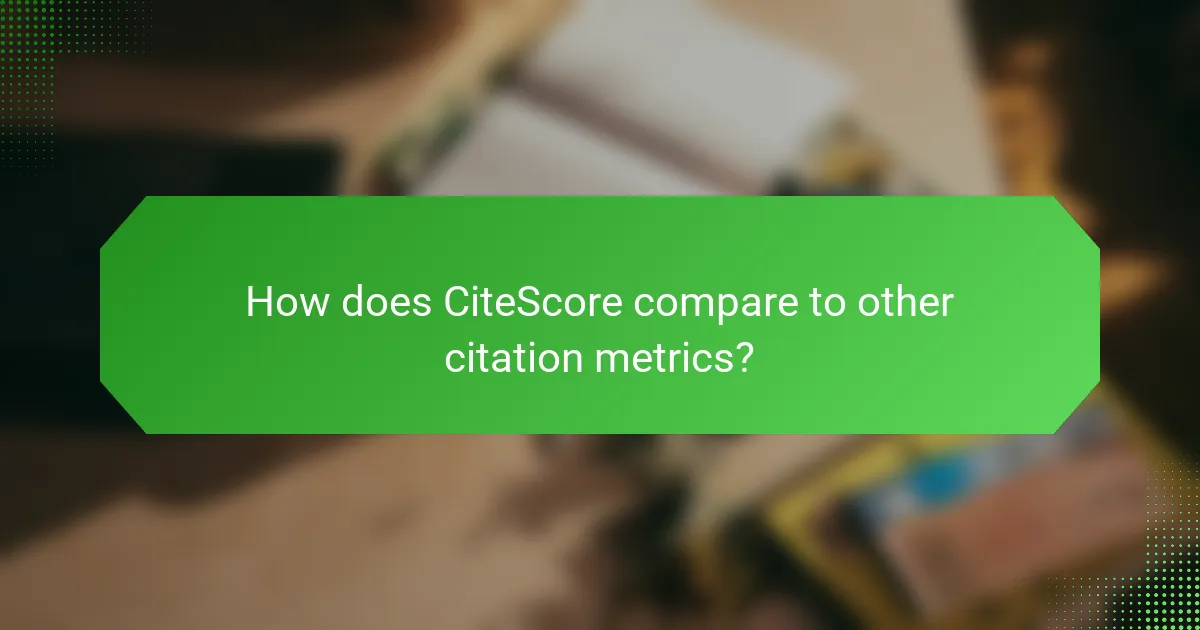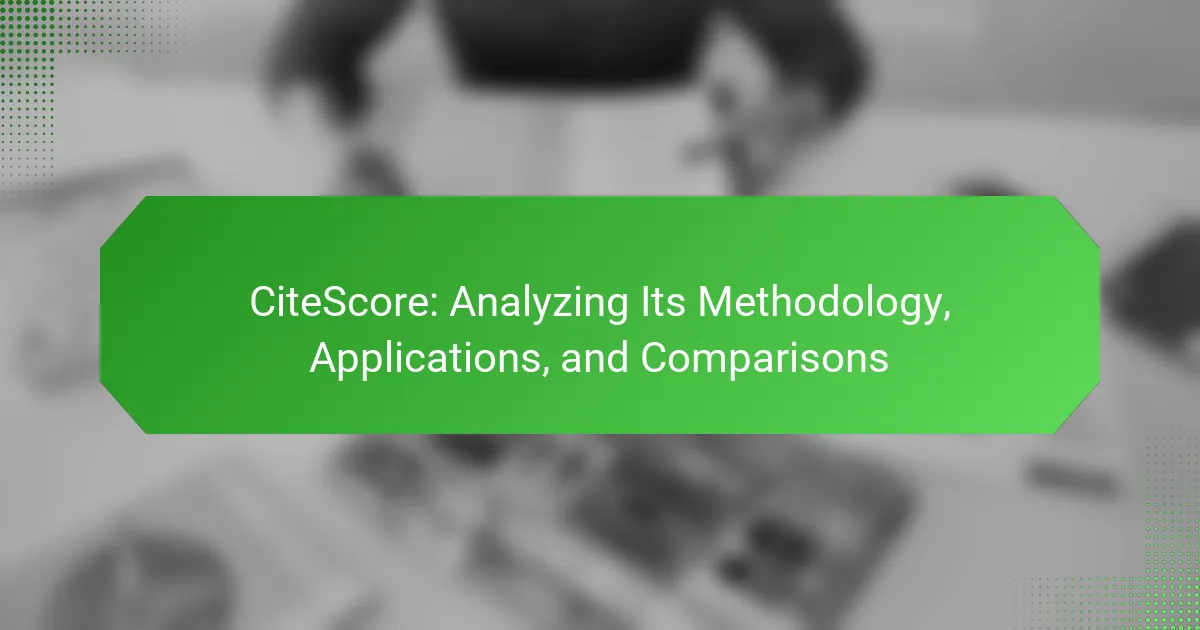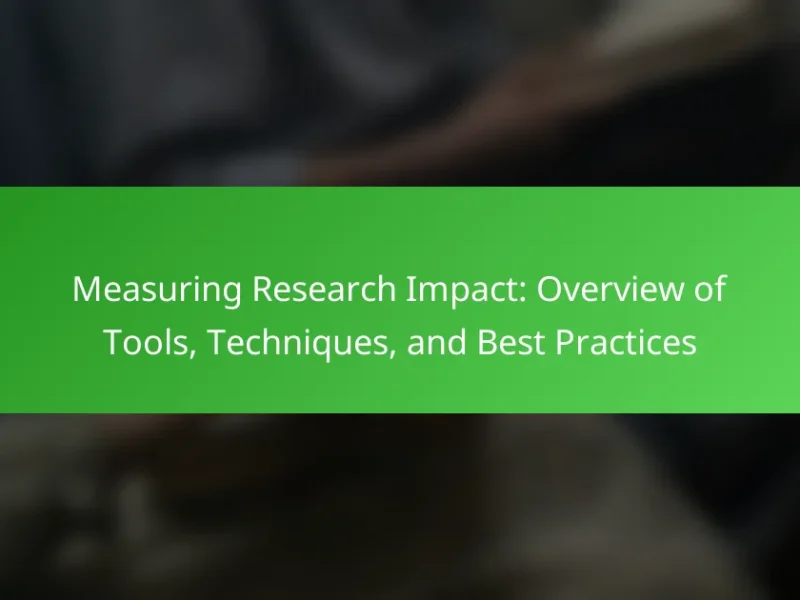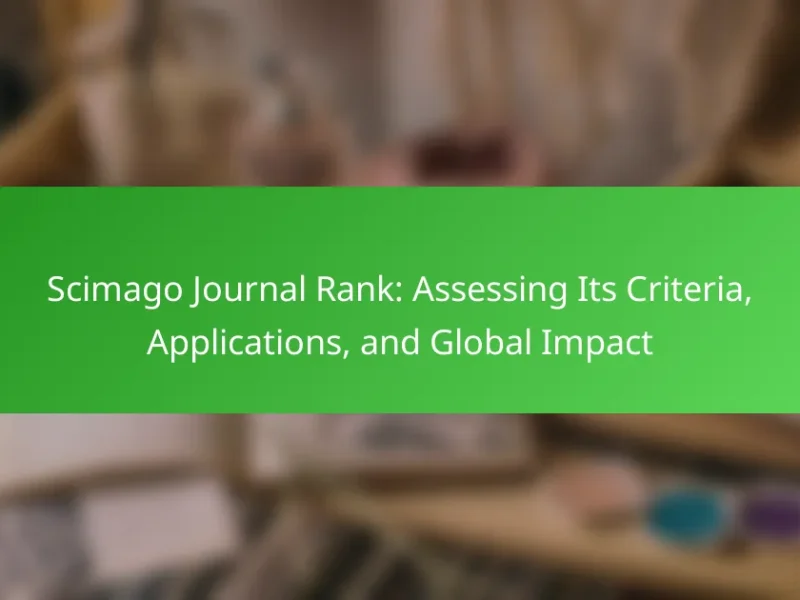CiteScore is a citation metric that evaluates the citation impact of academic journals by calculating the average number of citations received per document published over a three-year period, utilizing data from the Scopus database. This metric is essential for researchers, publishers, and institutions as it aids in assessing journal quality, promoting credibility, and benchmarking performance within various academic disciplines. Compared to other metrics like Impact Factor, CiteScore encompasses a wider range of document types and is updated annually, providing timely insights into citation trends. The article will analyze CiteScore’s methodology, its applications in academic publishing, and how it compares to other citation metrics, offering a comprehensive understanding of its role in research evaluation.

What is CiteScore?
CiteScore is a metric that measures the citation impact of academic journals. It calculates the average number of citations received in a specific year by articles published in the journal during the previous three years. This metric is calculated using data from Scopus, a comprehensive abstract and citation database. CiteScore is widely used to assess the quality and influence of journals in various fields. It provides researchers with a quantitative measure to compare journals within the same discipline. CiteScore values are updated annually, reflecting the most recent citation data. The metric is useful for authors deciding where to submit their work.
How is CiteScore calculated?
CiteScore is calculated by dividing the number of citations received in a year by the total number of documents published in the previous three years. This metric includes all types of documents, such as articles, reviews, and conference papers. For example, if a journal receives 200 citations in 2022 for documents published in 2019, 2020, and 2021, and published 100 documents in that period, the CiteScore would be 2.0. This calculation provides a measure of the journal’s impact and citation frequency within the academic community. The CiteScore metric is updated annually, reflecting the latest citation data and publication outputs.
What data sources are used in the CiteScore calculation?
CiteScore calculation uses data from Scopus, a comprehensive abstract and citation database. Scopus includes a wide range of scholarly articles from various disciplines. The data encompasses citation counts from articles published in the last four years. Additionally, it includes the number of citations received by these articles. This approach ensures that CiteScore reflects the citation impact of journals accurately. The methodology relies on a robust dataset, allowing for reliable comparisons across journals.
What time frame does CiteScore consider for its metrics?
CiteScore considers a three-year time frame for its metrics. This includes citations received in a particular year for articles published in the previous three years. For example, CiteScore for 2023 will include citations from 2023 for articles published in 2020, 2021, and 2022. This methodology allows for a comprehensive evaluation of journal performance over a recent period. The three-year window provides a balanced view of citation impact, reflecting both recency and relevance in academic publishing.
What are the key features of CiteScore?
CiteScore is a metric that measures the citation impact of academic journals. It calculates the average citations received per document published in a journal over a three-year period. The metric includes all types of documents, such as articles, reviews, and conference papers. CiteScore is updated annually, providing a current perspective on journal performance. It is widely used in academic publishing for evaluating journal quality. The metric is available through the Scopus database, which ensures comprehensive coverage of indexed journals. CiteScore is often compared to other metrics like Impact Factor and SNIP for a broader understanding of journal influence.
How does CiteScore differ from other citation metrics?
CiteScore measures the average citations received per document published in a journal over a three-year period. This timeframe distinguishes it from metrics like the Impact Factor, which typically uses a two-year period. CiteScore includes a broader range of document types, such as articles, reviews, conference papers, and data papers, whereas some metrics focus primarily on articles. Additionally, CiteScore is calculated using data from Scopus, which encompasses a vast array of journals, providing a comprehensive overview. This methodology contrasts with metrics like h-index, which considers both the number of publications and citations of an individual researcher or journal. These differences make CiteScore a distinct and valuable citation metric in academic publishing.
What types of publications are included in CiteScore?
CiteScore includes various types of publications. These publications are primarily scholarly articles, conference papers, and reviews. Additionally, it encompasses book chapters and data papers. Each type contributes to the overall citation metrics calculated by CiteScore. The inclusion of these diverse publication types allows for a comprehensive assessment of academic impact. This methodology ensures that multiple forms of scholarly communication are recognized in the evaluation process.

What are the applications of CiteScore?
CiteScore is used to evaluate the impact of academic journals. It helps researchers identify reputable journals for publication. Publishers utilize CiteScore to promote their journals’ credibility. Institutions leverage CiteScore for assessing research performance. It aids librarians in selecting journals for subscriptions. CiteScore also assists in benchmarking journals against their peers. Furthermore, it informs funding bodies about journal quality. Overall, CiteScore serves as a vital tool in academic publishing and research evaluation.
How can researchers utilize CiteScore in their work?
Researchers can utilize CiteScore as a metric to evaluate journal quality. CiteScore provides a measure of citations received by articles published in a journal over a three-year period. Researchers can compare the CiteScore of different journals to identify reputable publication venues. A higher CiteScore often indicates a journal’s influence in its field. This metric helps researchers decide where to submit their work. Additionally, CiteScore can assist in assessing the impact of their published research. By analyzing the CiteScore, researchers can identify trends in citation practices over time. This information can guide future research directions and collaborations.
What insights can CiteScore provide for selecting journals?
CiteScore provides valuable insights for selecting journals by offering a quantitative measure of journal impact. It calculates the average citations received per document published in a journal over a three-year period. This metric helps researchers gauge the relative importance of a journal within its field. Higher CiteScore values indicate greater visibility and influence among academic peers. Additionally, CiteScore includes metrics for various document types, enhancing the understanding of citation patterns. This allows authors to identify suitable journals that align with their research focus. Consequently, researchers can make informed decisions on where to submit their work based on citation performance.
How does CiteScore impact academic reputation?
CiteScore impacts academic reputation by providing a quantitative measure of journal citation impact. Higher CiteScores indicate that a journal’s articles are cited more frequently. This frequency can enhance the perceived quality and influence of the journal. Consequently, researchers and institutions often view journals with high CiteScores as more prestigious. This perception can influence where researchers choose to publish their work. Additionally, funding bodies may consider CiteScore when evaluating research proposals. Thus, a journal’s CiteScore can significantly affect the academic standing of its contributors.
What role does CiteScore play in institutional assessments?
CiteScore serves as a quantitative metric for evaluating the citation impact of academic journals. It is used by institutions to assess research quality and performance. Institutions often rely on CiteScore to benchmark their research output against peers. A higher CiteScore indicates greater citation frequency, suggesting a journal’s influence in its field. This metric helps institutions in decision-making regarding funding and resource allocation. Additionally, CiteScore can influence hiring and promotion decisions based on research productivity. Its calculation is based on the number of citations received by a journal’s articles over a three-year period. This data is sourced from Scopus, ensuring reliability and credibility in assessments.
How do universities use CiteScore in research evaluations?
Universities use CiteScore as a metric to evaluate the quality and impact of research publications. CiteScore provides a quantitative measure by calculating the average citations received per document published in a journal over a three-year period. This metric helps universities assess the performance of their faculty and research outputs. Institutions may use CiteScore to inform decisions on hiring, promotions, and funding allocations. Additionally, it aids in benchmarking against peer institutions and identifying trends in research impact. CiteScore is part of a broader set of evaluation tools, including impact factors and h-index, allowing for a comprehensive assessment of research quality.
What trends can CiteScore reveal about academic publishing?
CiteScore reveals several trends in academic publishing. It indicates the growth of open access publications. The increase in CiteScore values suggests rising citation impacts for journals. It highlights the interdisciplinary nature of research, as diverse fields show varying citation patterns. CiteScore also reflects the popularity of certain topics over time. For instance, emerging fields may experience rapid increases in citations. Additionally, it can indicate regional publishing trends, showing where research is being produced. Overall, CiteScore serves as a valuable metric for understanding the dynamics of academic publishing.

How does CiteScore compare to other citation metrics?
CiteScore is a citation metric that measures the average citations received per document published in a journal. It is calculated using data from Scopus, which includes a wide range of disciplines. Compared to other citation metrics like Impact Factor, CiteScore covers a broader range of document types, including conference papers and reviews. While Impact Factor is limited to articles indexed in the Journal Citation Reports, CiteScore provides a more comprehensive view of journal performance. Additionally, CiteScore is updated more frequently, offering timely insights into citation trends. Overall, CiteScore’s methodology allows for a more inclusive assessment of journal impact relative to other metrics.
What are the main differences between CiteScore and Impact Factor?
CiteScore and Impact Factor are both metrics used to evaluate journal quality. CiteScore measures the average citations received per document published in a journal over a three-year period. In contrast, Impact Factor calculates the average citations to articles published in a journal over the previous two years. CiteScore includes all types of documents, while Impact Factor typically considers only research articles and reviews. CiteScore is updated annually, whereas Impact Factor is released annually by Clarivate Analytics. Additionally, CiteScore is part of the Scopus database, while Impact Factor is associated with the Web of Science. These differences highlight the distinct methodologies and scopes of each metric.
How do the methodologies of CiteScore and Impact Factor differ?
CiteScore and Impact Factor differ primarily in their calculation methodologies. CiteScore measures the average citations received per document published in a journal over a three-year period. It includes all types of documents, such as articles, reviews, and conference papers. In contrast, Impact Factor calculates the average citations for articles published in a journal over the previous two years. Impact Factor only considers citable items, typically research articles and reviews. The inclusion criteria and time frames for citation analysis are the key distinctions between the two metrics. CiteScore provides a broader view of journal impact, while Impact Factor focuses on a more restricted set of publications.
What are the implications of these differences for researchers?
Differences in CiteScore methodologies impact researchers’ evaluation of journal quality. Variations in data sources can lead to discrepancies in citation counts. Researchers may select journals based on inaccurate metrics if they do not understand these differences. This can affect publication decisions, funding opportunities, and academic reputation. Researchers need to critically assess CiteScore alongside other metrics for a comprehensive evaluation. Understanding these implications ensures informed choices in academic publishing.
What are the advantages and disadvantages of using CiteScore?
CiteScore offers several advantages and disadvantages. One advantage is that it provides a comprehensive metric by including all types of documents, such as articles, reviews, and conference papers. This inclusivity allows for a broader assessment of journal impact. Another advantage is its accessibility; CiteScore data is freely available through Scopus, making it easy for researchers to obtain. Additionally, it is updated annually, reflecting recent citation trends.
On the downside, CiteScore can be influenced by self-citation, which may inflate scores. This potential bias can misrepresent a journal’s true impact. Furthermore, it does not account for the quality of citations, as it treats all citations equally, regardless of their context or significance. Lastly, its methodology may not align with all academic fields, leading to discrepancies in how impact is perceived across disciplines.
What are the limitations of CiteScore in measuring journal quality?
CiteScore has several limitations in measuring journal quality. First, it primarily focuses on citation counts rather than qualitative measures. This means it does not account for the context or significance of citations. Second, CiteScore is influenced by self-citations, which can artificially inflate scores. Third, it does not differentiate between types of articles, treating all equally regardless of their contribution to the field. Additionally, CiteScore is based on a three-year citation window, which may not reflect long-term impact. Lastly, it only includes journals indexed in Scopus, excluding many reputable journals not covered by this database. These limitations can result in a skewed perception of a journal’s true quality and impact.
How can researchers mitigate the limitations of CiteScore?
Researchers can mitigate the limitations of CiteScore by using multiple metrics for evaluation. Relying solely on CiteScore can lead to an incomplete assessment of journal quality. Incorporating additional metrics like Impact Factor and SCImago Journal Rank provides a broader perspective. Researchers should also consider qualitative factors such as editorial standards and peer-review processes. Engaging with citation analysis tools can help in understanding citation patterns better. Additionally, researchers can focus on the context of citations to evaluate relevance. Studies show that a multi-metric approach leads to more informed decisions about journal selection. For example, a 2021 study by Moed indicates that combining metrics enhances the accuracy of journal assessments.
What best practices should researchers follow when using CiteScore?
Researchers should follow several best practices when using CiteScore. First, they should understand that CiteScore measures the average citations received per document published in a journal. Researchers must compare CiteScore with other metrics for a comprehensive evaluation of journal quality. They should also consider the field-specific context of CiteScore, as citation practices vary across disciplines. It is essential to analyze the citation data over multiple years to identify trends. Researchers should use CiteScore in conjunction with qualitative assessments of journal content. They must remain aware of the limitations of CiteScore, including its inability to account for citation biases. Lastly, researchers should verify the accuracy of CiteScore data by consulting the official source, Scopus, for the most reliable information.
CiteScore is a metric that evaluates the citation impact of academic journals by calculating the average number of citations received by articles published in the previous three years. This article provides an in-depth analysis of CiteScore’s methodology, including its calculation process, data sources, and the time frame considered for metrics. It also discusses the applications of CiteScore in evaluating journal quality, its comparison with other citation metrics like Impact Factor, and the advantages and limitations of using CiteScore for researchers. Additionally, best practices for effectively utilizing CiteScore in academic publishing are outlined, ensuring a comprehensive understanding of its role in research evaluation.


